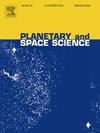High resolution olivine abundance mapping in the Copernicus crater combining spectral data of Chandrayaan-1 M3 and Kaguya MI
IF 1.7
4区 物理与天体物理
Q3 ASTRONOMY & ASTROPHYSICS
引用次数: 0
Abstract
We present a technique for improving the spatial resolution of satellite spectrophotometric data of the Moon's surface using an artificial neural network. We demonstrate this approach using the high-spectral low-spatial resolution Moon Mineralogy Mapper (M3) spectrophotometer and the low-spectral high-spatial resolution Multiband Imager (MI) Kaguya datasets for super-resolution olivine mapping over the Copernicus crater. The super-resolution of spectral maps is achieved by correlating spectral data of these instruments using a multilayer perceptron. An important advantage of the method is the use of a single data frame from each dataset to study a particular lunar region. The obtained maps of the olivine abundance provide new spatial context of the investigated mineral distribution: olivine-rich surface units become visible primarily as flow tubes, lava ponds on the crater walls and boulder outcrops associated with high olivine content (up to 90 vol%) at the central peak of the investigated crater. The content of the olivine-reaches deposits of the area on the central peak reaches up to 35 vol % of the lunar regolith.
结合Chandrayaan-1 M3和Kaguya MI光谱数据的哥白尼陨石坑高分辨率橄榄石丰度制图
提出了一种利用人工神经网络提高月球表面卫星分光光度数据空间分辨率的方法。我们使用高光谱低空间分辨率月球矿物绘图仪(M3)分光光度计和低光谱高空间分辨率多波段成像仪(MI) Kaguya数据集对哥白尼陨石坑的超分辨率橄榄石进行了演示。光谱图的超分辨率是通过使用多层感知器将这些仪器的光谱数据进行关联来实现的。该方法的一个重要优点是使用来自每个数据集的单个数据帧来研究特定的月球区域。获得的橄榄石丰度图为所研究的矿物分布提供了新的空间背景:富含橄榄石的表面单元主要可见于流管、火山口壁上的熔岩池和与所研究的火山口中央峰值的高橄榄石含量(高达90 vol%)相关的卵石露头。该地区中部峰上的橄榄岩沉积物含量高达月球风化层的35%。
本文章由计算机程序翻译,如有差异,请以英文原文为准。
求助全文
约1分钟内获得全文
求助全文
来源期刊

Planetary and Space Science
地学天文-天文与天体物理
CiteScore
5.40
自引率
4.20%
发文量
126
审稿时长
15 weeks
期刊介绍:
Planetary and Space Science publishes original articles as well as short communications (letters). Ground-based and space-borne instrumentation and laboratory simulation of solar system processes are included. The following fields of planetary and solar system research are covered:
• Celestial mechanics, including dynamical evolution of the solar system, gravitational captures and resonances, relativistic effects, tracking and dynamics
• Cosmochemistry and origin, including all aspects of the formation and initial physical and chemical evolution of the solar system
• Terrestrial planets and satellites, including the physics of the interiors, geology and morphology of the surfaces, tectonics, mineralogy and dating
• Outer planets and satellites, including formation and evolution, remote sensing at all wavelengths and in situ measurements
• Planetary atmospheres, including formation and evolution, circulation and meteorology, boundary layers, remote sensing and laboratory simulation
• Planetary magnetospheres and ionospheres, including origin of magnetic fields, magnetospheric plasma and radiation belts, and their interaction with the sun, the solar wind and satellites
• Small bodies, dust and rings, including asteroids, comets and zodiacal light and their interaction with the solar radiation and the solar wind
• Exobiology, including origin of life, detection of planetary ecosystems and pre-biological phenomena in the solar system and laboratory simulations
• Extrasolar systems, including the detection and/or the detectability of exoplanets and planetary systems, their formation and evolution, the physical and chemical properties of the exoplanets
• History of planetary and space research
 求助内容:
求助内容: 应助结果提醒方式:
应助结果提醒方式:


